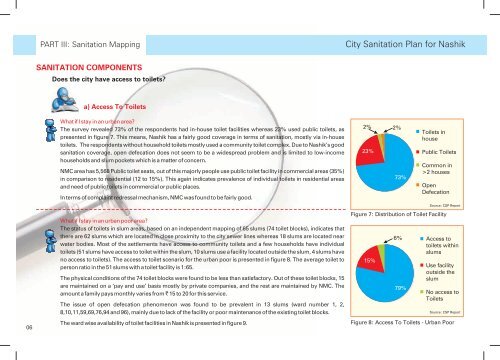City Sanitation Plan for Nashik - SuSanA
City Sanitation Plan for Nashik - SuSanA
City Sanitation Plan for Nashik - SuSanA
You also want an ePaper? Increase the reach of your titles
YUMPU automatically turns print PDFs into web optimized ePapers that Google loves.
PART III: <strong>Sanitation</strong> Mapping<br />
<strong>City</strong> <strong>Sanitation</strong> <strong>Plan</strong> <strong>for</strong> <strong>Nashik</strong><br />
SANITATION COMPONENTS<br />
Does the city have access to toilets?<br />
06<br />
a) Access To Toilets<br />
What if I stay in an urban area?<br />
The survey revealed 73% of the respondents had in-house toilet facilities whereas 23% used public toilets, as<br />
presented in figure 7. This means, <strong>Nashik</strong> has a fairly good coverage in terms of sanitation, mostly via in-house<br />
toilets. The respondents without household toilets mostly used a community toilet complex. Due to <strong>Nashik</strong>’s good<br />
sanitation coverage, open defecation does not seem to be a widespread problem and is limited to low-income<br />
households and slum pockets which is a matter of concern.<br />
NMC area has 5,568 Public toilet seats, out of this majorly people use public toilet facility in commercial areas (35%)<br />
in comparison to residential (12 to 15%). This again indicates prevalence of individual toilets in residential areas<br />
and need of public toilets in commercial or public places.<br />
In terms of complaint redressal mechanism, NMC was found to be fairly good.<br />
What if I stay in an urban poor area?<br />
The status of toilets in slum areas, based on an independent mapping of 65 slums (74 toilet blocks), indicates that<br />
there are 62 slums which are located in close proximity to the city sewer lines whereas 18 slums are located near<br />
water bodies. Most of the settlements have access to community toilets and a few households have individual<br />
toilets (51 slums have access to toilet within the slum, 10 slums use a facility located outside the slum, 4 slums have<br />
no access to toilets). The access to toilet scenario <strong>for</strong> the urban poor is presented in figure 8. The average toilet to<br />
person ratio in the 51 slums with a toilet facility is 1:65.<br />
The physical conditions of the 74 toilet blocks were found to be less than satisfactory. Out of these toilet blocks, 15<br />
are maintained on a ‘pay and use’ basis mostly by private companies, and the rest are maintained by NMC. The<br />
amount a family pays monthly varies from ` 15 to 20 <strong>for</strong> this service.<br />
The issue of open defecation phenomenon was found to be prevalent in 13 slums (ward number 1, 2,<br />
8,10,11,59,69,76,94 and 96), mainly due to lack of the facility or poor maintenance of the existing toilet blocks.<br />
The ward wise availability of toilet facilities in <strong>Nashik</strong> is presented in figure 9.<br />
2%<br />
23%<br />
15%<br />
2%<br />
73%<br />
6%<br />
79%<br />
Toilets in<br />
house<br />
Public Toilets<br />
Common in<br />
>2 houses<br />
Open<br />
Defecation<br />
Source: CSP Report<br />
Figure 7: Distribution of Toilet Facility<br />
Access to<br />
toilets within<br />
slums<br />
Use facility<br />
outside the<br />
slum<br />
No access to<br />
Toilets<br />
Source: CSP Report<br />
Figure 8: Access To Toilets - Urban Poor
















